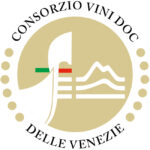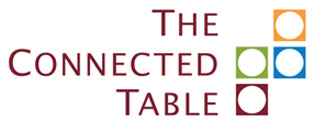As overall global wine consumption decreases, there are some bright spots including Pinot Grigio which remains a category leader in white wines. According to IWSR Drinks Market Analysis, Pinot Grigio /Pinot Gris ranks second after Chardonnay as the most widely consumed (42%) still white wine in the U.S.
But how well do consumers know the origin of their Pinot Grigio?
The Connected Table attended a symposium November 3-4 in Verona organized by the Consorzio delle Venezie to address global trends, market changes and prospects for its signature Pinot Grigio Delle Venezie D.O.C. (Denominazione di Origine Controllata).
During the two days, we had the opportunity to meet and speak with Consorzio President Albino Armani, proprietor of Azienda Agricola Albino Armani. And we heard valuable insights from both Italian wine and agricultural industry leaders and a range of speakers in wine media, commerce, and research who included: Felicity Carter (Business of Drinks), Lulie Halstead (Wine Intelligence), Kristi Paris (Vivino), David Gluzman (Wine Folly) and Daniele Cernilli (DoctorWine).
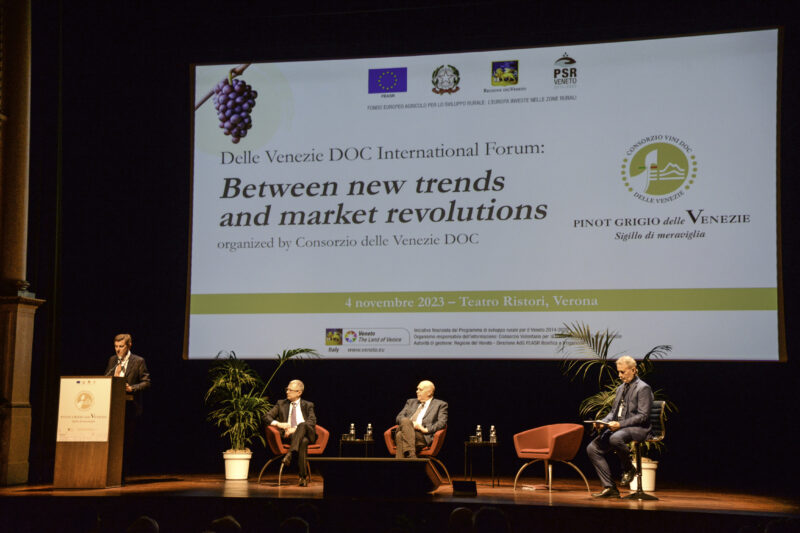
Conference speakers addressed trends and opportunities in the Global Market for Pinot Grigio delle Venezie.
Four takeaway themes emerged from this informative event:
Education
More education is needed to promote the regional identity of Pinot Grigio Delle Venezie D.O.C. to both consumers and trade. Pinot Grigio wine is produced throughout the world, and this wine is made in many areas of Italy. The majority of Pinot Grigio- 82%- is produced in the cooler climate Delle Venezie, known as “Triveneto.” This is a very large area covering three distinct regions, each with their own microclimates and soil conditions: Friuli -Venezia- Giulia to the east closer to the Adriatic Sea, Trento to the north near the Dolomites and in the hilly Veneto which stretches roughly from Venice to Lake Garda and south to Padua.
Conference speakers including Riccardo Velasco, Director at CREA– Center for Research in Agriculture and Analysis of Agricultural Economic explained the geographical identity of each production area. We participated in a blind tasting of Pinot Grigio Delle Venezie D.O.C. wines which underscored the nuanced characteristics for each area.
Another recurring topic was the importance of providing more focused education to on-premises trade, including sommeliers and beverage directors, about the distinction of Pinot Grigio Delle Venezie D.O.C. and the importance of identifying this designation on wine lists. Pinot Grigio is a popular by-the-glass offering in restaurants throughout the U.S. It may be identified as being from “Italy” but not “Delle Venezie D.O.C.” This presents an opportunity for the Consorzio and its producer members to strengthen the regional identity of their wines.
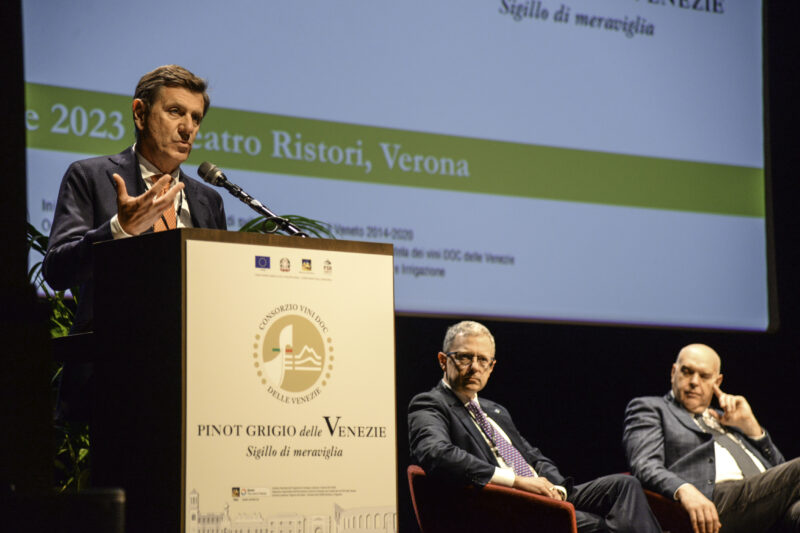
Albino Armani, president of the Consorzio delle Venezie, addresses the audience.
Changes in Consumption
Several key developments in wine consumption were addressed. These included reduced consumption of wine in the U.S.A. and other markets, a growing preference for low and no alcohol beverages, more interest in natural and organic wines, and the desire among consumers to seek out the “new and different” to try.
We learned that half the world’s population does not consume alcohol, according to data provided by Herbert Dorfmann, an Italian agronomist and member of the European Parliament Committee on Agriculture and Rural Development. Given that two large global religions, Islam and Buddhism, forbid consumption of alcohol, that did not come as a surprise to us. A more interesting statistic was presented by Lulie Halstead, Founder of Wine Intelligence and non-executive Director IWSR and Trustee: 7% of people living in the U.S. abstain from consuming alcohol and 54% of GenZ (individuals born between the late 1990s and 2010s) do not drink alcohol beverages.
“Consumers relationship with alcohol has changed,” Halstead told the audience which consistent mainly of producers, wine marketers and journalists. Factors that have impacted this development include a focus on healthier lifestyles, more casual dining, economics and eating at home versus dining out. When young consumers drink alcohol, they are turning to spirits and lower ABV session cocktails.
“The embrace of moderate consumption presents a potential growth opportunity,” stated Sandro Sartor, CEO and President of Ruffino and President of Wine in Moderation, a coalition of wine producers who support and promote sustainable and responsible consumption. Through a detailed sales forecast chart Sartor addressed how this health-focused movement can drive more sales. Pinot Grigio Delle Venezie DOC wines tend to have a lower ABV- a minimum of 11% and usually less than 13%. They are also more favorably priced and perceived as an easy to drink white wine for consumers.
“The health sector has contributed to changing lifestyles, especially among young people. People are looking for products that bring well-being and this also satisfies a health need; this also means paying attention to calorie consumption, which would have less impact in a de-alcoholised wine,” said Sartor.
That said, Halstead and Sartor both highlighted another important development and opportunity: While consumers may be drinking less, they are also “trading up” to what they perceive as better-quality brands and unique tasting experiences. “What we foresee for the future is a consumption growth which will mainly involve premium quality products,” said Halstead.
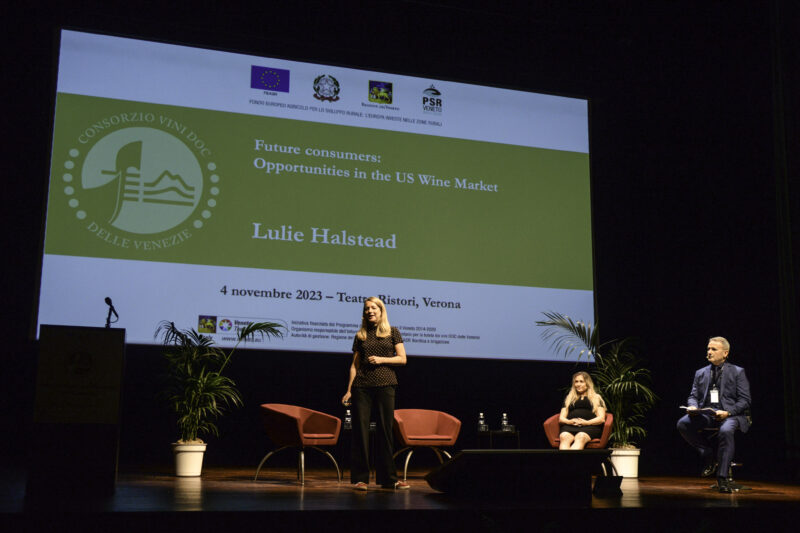
Lulie Halstead addresses premiumization,
Which leads to two more takeaways:
Premiumization
When a category is already a market leader, how do you strengthen your position and drive more sales? The answer is “premiumization” to take advantage of the “trading up” trend. This means refocusing Pinot Grigio Delle Venezie D.O.C. wines on “quality over value” and an emphasis on authenticity and sense of place. Future growth will be achieved by premium pricing. But, for consumers used to reaching for that basic $10.99-a-bottle of Pinot Grigio in the supermarket, it also means strengthening the perception of the wine and reinforcing a desirability for taste and quality.
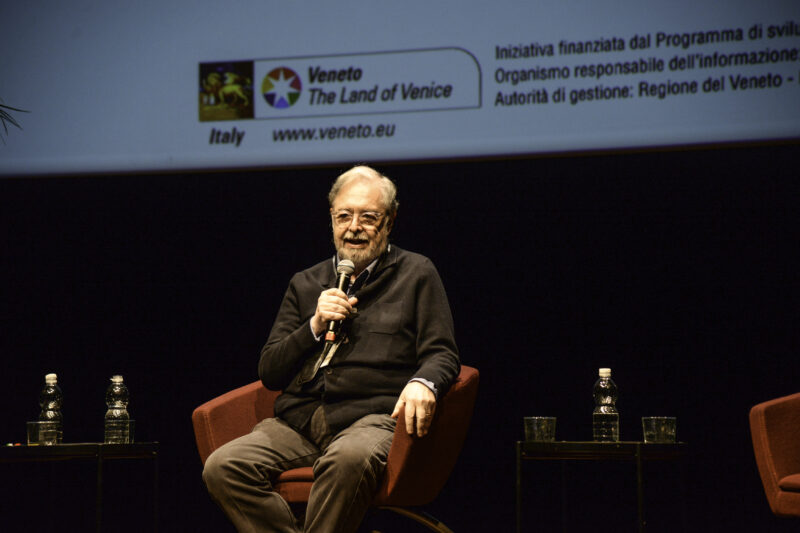
Daniele Cernilli, “Doctor Wine,” addresses strategies to improve the positioning of Pinot Grigio delle Venezie in Italy.
And leads to the final takeaway:
Establishing a Connection
This point drives back full circle to “Education” and teaching both trade and consumers about the origins and quality designation of Pinot Grigio Delle Venezie D.O.C. starting with history and location. The Veneto area being a popular tourist destination helps create that stronger connection. Travelers discover wines and look for them when they are back home. That is where trade education is important since consumers who have visited the Veneto will seek out wines they have tasted when dining out.
Creating a connection also means telling the stories of the producers. The Triveneto region’s many producers range from large corporations to smaller multi-generational families. Identifying not only where the wine is made but also who are the people behind it will create a stronger identity for the region.
Compelling imagery is also important, noted David Gluzman, CEO of Wine Folly, which has an audience of 400,000 GenX wine consumers. Maps, illustrations, photos, and visually driven educational tools like those found on Wine Folly’s website are good examples. Photos on social media showing the region, food pairings and images of wine families and their wineries also help share the story.
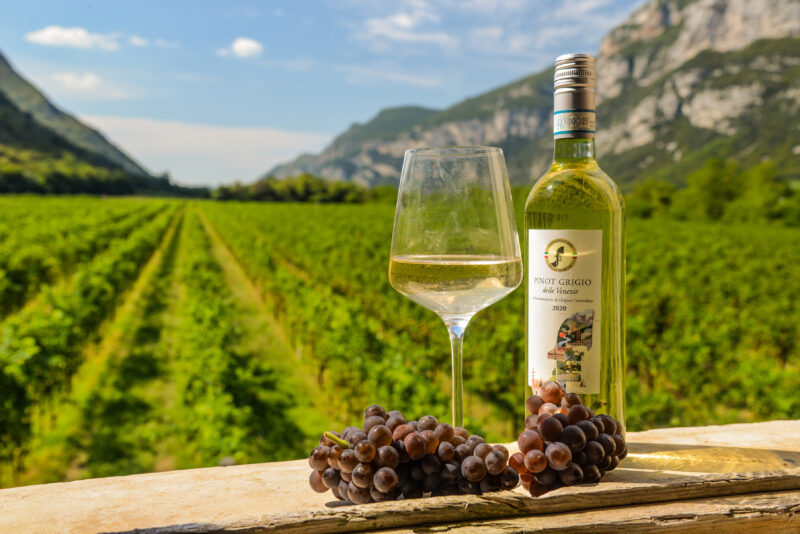
Pinot Grigio delle Venezie represents 82% of all Pinot Grigio produced in Italy.
As we like to say at The Connected Table: Words tell; photos sell. Put faces to the places by sharing stories instead of sales pitches.
For more information visit www.pinotgrigio.wine and www.dellevenezie.it
